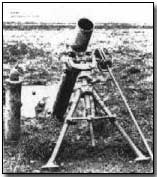Who's Who - Wilfred Stokes
 Frederick Wilfred Scott Stokes
(1860-1927) was the inventor of the simple but highly effective Stokes
mortar, which became the standard British mortar of the First World War.
Frederick Wilfred Scott Stokes
(1860-1927) was the inventor of the simple but highly effective Stokes
mortar, which became the standard British mortar of the First World War.
A civil engineer and inventor, Stokes was Chairman and Managing Director of Ransomes & Rapier, an engineering company based in Ipswich which chiefly manufactured cranes.
Although Stokes' names became synonymous with the most renowned mortar of World War One he only began experimenting with its design towards the close of 1914, once war had actually begun. It is a testament to the brilliant simplicity of his design that it acquired immediate renown.
The British were at that time keen to develop a match for the German mortars (minenwerfers) in use against the French in the east (and soon afterwards against the British themselves on the Western Front).
The mortar was by no means a new weapon, although it had fallen out of usage since the Napoleonic era. Indeed, in the interim while the British and French hastened to construct new mortars they resorted to using century old stocks of the weapon.
Curiously, Stokes' design was initially rejected in June 1915 on the grounds that it was unable to utilise existing British mortar ammunition. It required the combined intervention of David Lloyd George (then Minister of Munitions) and Lieutenant-Colonel J.C. Matheson of the Trench Warfare Supply Department (reporting to Lloyd George) to push through manufacture of the Stokes mortar. Douglas Haig was another early admirer of the weapon.
It consisted chiefly of a smooth metal tube fixed to a base plate (to absorb recoil) with a light bi-pod mount. When a bomb was dropped into the tube an impact sensitive cartridge at the base of the bomb would make contact with a firing pin at the base of the tube, thereby ejecting the bomb.
3-inches in size the cast-iron mortar bomb itself weighed around 4.5 kg. It was fitted with a modified hand grenade fuse on the front, with a perforated tube (with minor propellant charge) and impact-sensitive cap at the back.
The Stokes mortar could fire as many as 22 bombs per minute and had a maximum range of 1,200 yards. Most mortars in use today are direct descendants of the Stokes mortar.
Stokes himself was subsequently knighted in recognition of the success of his invention. He died in 1927.
A Greyback was a British Army shirt.
- Did you know?
